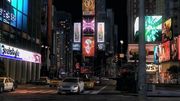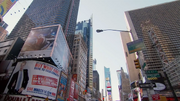London is the capital and largest city of England and the United Kingdom, with a population of just under 9 million. It stands on the River Thames in south-east England at the head of a 50-mile (80 km) estuary down to the North Sea, and has been a major settlement for two millennia. The City of London, its ancient core and financial centre, was founded by the Romans as Londinium and retains its medieval boundaries. [1]
Coverage[]
London is featured in the documentary and Outbreak while it is also settled in Crypt of Civilization.
It begins in 1 week after people that without royal clock-mechanics to wound the clock, Big Ben would chimes for one last time before the chimes stop chiming forever, but the tower leaned 8.6 inches to the northwest of the tower which would get worse overtime.
In 2 weeks after people, in the Buckingham Palace, the Queen's corgis are all alone and hungry. However, they can survive by drinking water through the 76 bathrooms and eating food from the Royal Kitchen which could last for a few months and just after 3 months, the royal corgis depleted the food source and have escape the Buckingham Palace as they begin to venture into the abandoned city.
In 5 years after people, the gates of Buckingham Palace is being breached by vines and moss.
In 25 years after people, the Thames Barrier, once protected the city from tidal surges coming from the North Sea, is left unmanned causing the city to be flooded.
In 50 years after people, the descendants of royal corgis still prowl the streets of London but are no longer the breed that the Queen would recognize because after several generations of breeding with other dogs, any traits of their royal lineage are long gone and have evolved into a pack of wild hounds.

Big Ben collapses.
In 100 years after people, Big Ben is covered with vegetation, its windows have blown out, chunks of decorative stonework have chipped away, and over decades, the Thames River continually folds the surrounding banks which slowly rots Big Ben's foundations. Gordon Masterton stated that the tilt would gradually increase, becoming unstable till gravity takes over causing the tower to collapse to the ground. Meanwhile in London's financial district, the Gherkin is being stripped away because of the individual glazing panels that begin to fall out of the external skin as the effects of wind, sun, and rain have an aggravating effect on the condition of the materials.

The 10,000 Year Clock lay rest in the ruins of the Science Museum.
At 150 years after people, at the Science Museum, time has run out prematurely for the 10,000 Year Clock because right after people, it stopped dead in the first year since it require to have humans to wind the prototype every few months and after 150 years, it lies in pieces as the stone structure of the Science Museum collapsed not long ago. Not far away at the Science Museum, the joints of the Gherkin being exposed to corrosive moisture fails and the floors collapse in a pancake effect but remarkably, the diamond shaped supports still maintain the building's skeleton and while it is weakened, the Gherkin still stands unlike most other skyscrapers.

The Gherkin collapse.
In 200 years after people, the Tower Bridge begins to fall apart. In 300 years after people, the English weather has seeped into cracks in the structure seal of the Gherkin. Gordon Masterton stated that it will be attacked by corrosion and the structural elements will be progressively weakened until a gust of wind in a very extreme storm deliver blow. A brace buckles, triggering chain reactions in the trusses until the entire 30,000 ton framework of the Gherkin fully yields to the force of gravity and collapse into the skyline, destroying the buildings of the financial district in the process like St Andrew Undershaft.
Transformation[]

The streets of London is flooded.
Nothing is known about the complete transformation of London, however judging from the documentary, London would be flooded at least partially. Plant life could be seen flourishing on the ruins of the buildings and skyscrapers while others the structures could last a long time but its very speculative, or just a background. London could become a wetlands in the future or from the rising sea level, to be submerged into the North Sea, similar to Amsterdam.
Gallery[]
Series
Official Concept
Fanon Wiki[]
 |
 London has some more coverage on the Life After People Fanon Wiki. (Note that the events' timelines may be different.) |








